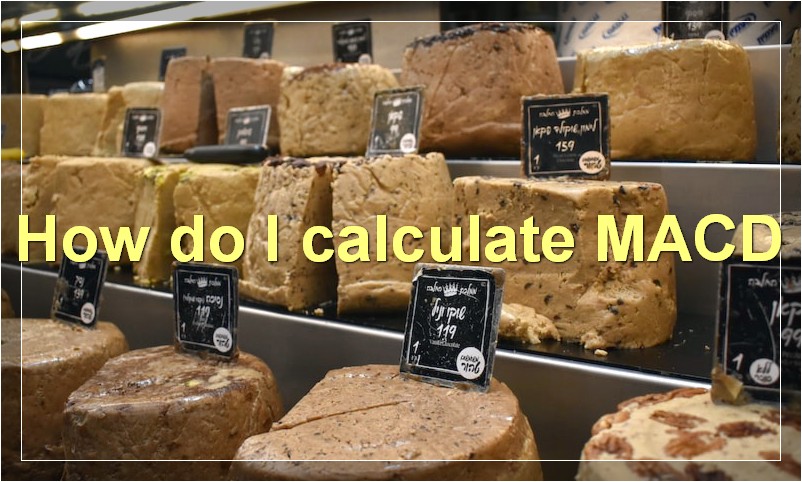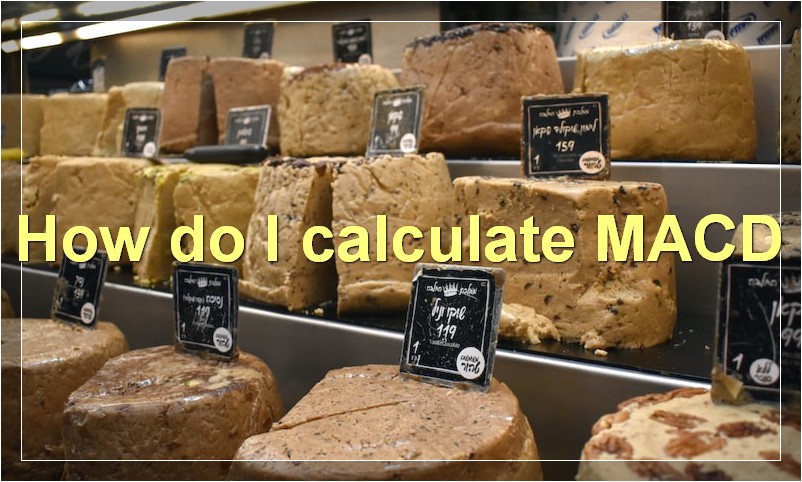The moving average convergence divergence (MACD) is a popular tool among traders. This technical indicator can be used to identify trends, momentum, and even potential reversals. In this article, we will discuss how to use MACD for trading.
How do I read a MACD chart
When it comes to technical analysis, one of the most popular indicators is the MACD (Moving Average Convergence Divergence) chart.
The MACD is a trend-following momentum indicator that shows the relationship between two moving averages of prices. The MACD line is the difference between the 12-day EMA (exponential moving average) and the 26-day EMA.
The signal line is a 9-day EMA of the MACD line. A buy signal occurs when the MACD line crosses above the signal line and a sell signal occurs when the MACD line crosses below the signal line.
The MACD histogram is used to gauge the strength of the current trend. The histogram is positive when the MACD is above the signal line and negative when the MACD is below the signal line.
Here are some tips on how to read a MACD chart:
1. Look for crossovers – As mentioned earlier, crossovers are a popular way to trade with the MACD. A crossover occurs when the MACD line crosses either above or below the signal line. A bullish crossover occurs when the MACD line crosses above the signal line and signals an opportunity to buy. A bearish crossover occurs when the MACD line crosses below the signal line and signals an opportunity to sell.
2. Look for divergences – A divergence occurs when the price action on the chart is not confirmed by the MACD. A bullish divergence occurs when the prices are making new lows but the MACD is not. This is often seen as a sign that the current downtrend is losing momentum and could be poised for a reversal. A bearish divergence occurs when prices are making new highs but the MACD is not. This is often seen as a sign that the current uptrend is losing momentum and could be poised for a reversal.
3. Use support and resistance levels – TheMACD can also be used to identify support and resistance levels. When prices are trading below theMACD, it shows that there is selling pressure and resistance could be found attheMACD level. When prices are trading abovetheMACD, it shows that there is buying pressure and support could be found at themacro level.
4. Use trailing stops – A trailing stop is a dynamic stop that moves up or down asthe price action moves in your favor. This type of stop can help you lock in profits while giving you some flexibility in case of a sudden reversal.
How do I calculate MACD

MACD is a technical analysis indicator that stands for Moving Average Convergence Divergence. MACD is calculated by subtracting the 26-period exponential moving average (EMA) from the 12-period EMA. MACD lines are used to identify trend direction and possible trend reversals.
The MACD line is the faster line because it is based on a shorter time period than the signal line. The signal line is the slower line because it is based on a longer time period. The MACD histogram is the difference between the MACD line and the signal line. The histogram is positive when the MACD line is above the signal line and negative when the MACD line is below the signal line.
The MACD indicator can be used to identify bullish or bearish divergences. A bullish divergence occurs when the MACD line makes a new high while prices fail to make a new high. This indicates that prices may be about to reverse to the upside. A bearish divergence occurs when the MACD line makes a new low while prices fail to make a new low. This indicates that prices may be about to reverse to the downside.
What is the MACD formula
The MACD formula is a technical analysis tool that is used to measure market momentum. The MACD stands for Moving Average Convergence Divergence. The MACD formula is calculated by subtracting the 26-day exponential moving average (EMA) from the 12-day EMA. The resulting line is then plotted on a chart along with a signal line that is generated by taking the nine-day EMA of the MACD line. buy and sell signals are generated when the MACD line crosses above or below the signal line.
What is the difference between MACD and RSI
There are a few key differences between MACD and RSI. First, MACD is a trend following indicator while RSI is a momentum indicator. Second, MACD uses exponential moving averages (EMA) while RSI uses simple moving averages (SMA). Finally, MACD has two lines – the MACD line and the signal line – while RSI only has one.
What is the difference between MACD and stochastics
There are a few key differences between MACD and stochastics. First, MACD is a lagging indicator, while stochastics are a leading indicator. This means that MACD gives signals after the fact, while stochastics give signals before the fact. Second, MACD is a trend following indicator, while stochastics can be used to trade both trends and reversals. Third, MACD is based on price action, while stochastics are based on price and volume. Finally, MACD is more suited for use on longer timeframes, while stochastics can be used on any timeframe.
How do you use MACD to trade

The MACD is a versatile tool that can be used to trade a variety of market conditions. In this article, we will discuss how to use the MACD to trade both trend and range-bound markets.
The MACD is a lagging indicator, which means it is based on past prices. As such, it is best used in conjunction with other indicators or forms of analysis. In a trending market, the MACD can be used to identify the direction of the trend and potential entry and exit points. In a range-bound market, the MACD can be used to identify overbought and oversold conditions.
When using the MACD to trade a trending market, it is important to look for confirmation from other indicators. For example, you might look for the MACD line to cross above the signal line before entering a long trade, or you might look for the MACD line to cross below the signal line before entering a short trade.
When using the MACD to trade a range-bound market, you might enter trades when the MACD line crosses above or below the signal line. Alternatively, you might wait for the MACD histogram to move into positive or negative territory before entering a trade.
No matter what type of market you are trading, it is always important to use stop-loss orders to protect your capital. The MACD can be a helpful tool in identifying potential entry and exit points, but it should not be relied upon exclusively. As with any trading strategy, there is no guaranteed path to success. However, by combining the MACD with other technical indicators or forms of analysis, you can increase your chances of making profitable trades.
What are the benefits of using MACD
There are numerous benefits of using MACD when trading stocks, commodities or currencies. MACD is a popular technical indicator that is used by many traders to identify trend changes and potential trade entry and exit points. MACD stands for Moving Average Convergence Divergence and is calculated by subtracting the 26-period exponential moving average (EMA) from the 12-period EMA. The resulting line is then plotted on a chart along with a 9-period EMA of the MACD line, which is referred to as the signal line.
MACD can be used to identify both bullish and bearish price momentum. A bullish MACD crossover occurs when the MACD line crosses above the signal line, while a bearish MACD crossover occurs when the MACD line crosses below the signal line. These crossovers can be used as potential trade entry signals. In addition, MACD can be used to identify overbought and oversold conditions in the market. When the MACD line is above zero, it indicates that prices are generally rising, while when the MACD line is below zero, it indicates that prices are generally falling.
Another benefit of using MACD is that it can be used in conjunction with other technical indicators to form a complete trading system. For example, many traders use MACD in combination with support and resistance levels, Fibonacci retracements or moving averages to make more informed trading decisions.
Overall, MACD is a versatile technical indicator that can be used in a variety of ways to improve your trading results. If you are not currently using MACD in your trading, it may be worth considering adding it to your toolkit.
What are the drawbacks of using MACD
There are a few drawbacks of using MACD. First, MACD is based on moving averages, which are lagging indicators. This means that MACD will always be behind the price action, and you may miss out on some potential profits. Second, MACD is a trend-following indicator, which means it will only tell you about the current trend. It can’t predict reversals or market turning points. Finally, MACD is a bit more complex than some other technical indicators, and it may take some time to learn how to use it effectively.
Is MACD reliable
Yes, MACD is a reliable indicator for assessing the strength of a trend. By comparing the 26-day exponential moving average (EMA) with the 12-day EMA, MACD measures the distance between these two moving averages. When the 26-day EMA is greater than the 12-day EMA, MACD is positive and indicates an up trend. Conversely, when the 12-day EMA is greater than the 26-day EMA, MACD is negative and indicates a down trend.
What are some tips for reading MACD charts
The MACD chart is a technical analysis tool that measures the momentum of a security. The MACD is calculated by subtracting the 26-day exponential moving average (EMA) from the 12-day EMA. A nine-day EMA of the MACD, called the “signal line”, is then plotted on top of the MACD line, which can help signal buy and sell opportunities.MACD charts can be used to identify trends and trend reversals, as well as to gauge the strength of a trend. When the MACD line rises above the signal line, it is a bullish signal, indicating that the security is gaining momentum and may continue to rise. Conversely, when the MACD line falls below the signal line, it is a bearish signal, indicating that the security is losing momentum and may continue to fall.

